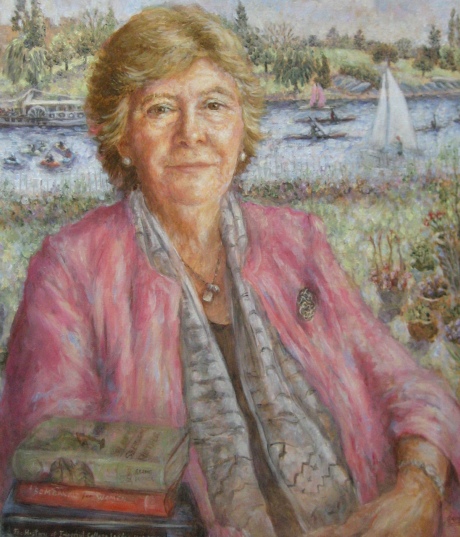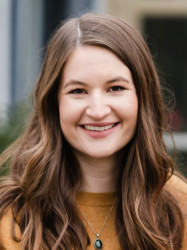
Artist Tess Barnes, Professor Dame Julia Higgins and Provost Professor James Stirling celebrate the portrait unveiling.

Imperial is to house a portrait of eminent polymer scientist Professor Dame Julia Higgins, it was announced last week.
The portrait, painted by prominent artist Tess Barnes, will be the first of an Imperial woman to hang at the College.
The historic occasion was marked with a reception held on Monday 16 June, where Professor James Stirling formally unveiled the portrait. Speaking at the event, he said: “This portrait reminds us of the fundamental contributions Julia Higgins has made to our community over her time with Imperial and I’m very pleased that we have this permanent tribute to celebrate them and to inspire others.”
This portrait reminds us of the fundamental contributions Julia Higgins has made to our community over her time with Imperial
– Professor James Stirling
Provost
Professor Dorothy Griffiths OBE, Provost’s Envoy for Gender Equality, said: “As a world-class academic, a champion of equality in science and a leader within higher education, Julia has made a profound and lasting impact on the College that few can rival.”
“It is especially fitting that first portrait of an Imperial woman to hang here should be of Julia, who has been committed to the advancement of women in academia throughout her career. Her tireless efforts are an inspiration to us all.”

Ms Barnes originally created the painting as part of a collection called ‘’Drawn to Science’, which features portraits of some of the world’s most distinguished scientists. Nobel Laureate Professor Sir Harry Kroto, evolutionary biologist and writer Richard Dawkins and world-leading surgeon and Imperial academic Professor the Lord Darzi are among others to have sat for her as part of the series.
As a world-class academic, a champion of equality in science and a leader within higher education, Julia has made a profound and lasting impact on the College that few can rival
– Professor Dorothy Griffiths OBE
Professor Higgins, who is now a Senior Research Investigator in Imperial’s Department of Chemical Engineering, pioneered the use of a technique called neutron scattering to investigate materials, particularly polymers.Having been with the College since 1976, she has acted as Dean of the City and Guilds College, Head of Department, and Principal of the Faculty of Engineering
She was the first woman to be awarded Fellowship of both the Royal Society and the Royal Academy of Engineering, and she was named Dame Commander of the Order of the British Empire in 2001.
In addition to her illustrious research career, Professor Higgins is also a champion of female scientists. She played a founding role in the Athena project, a UK wide government funded activity to improve recruitment, retention and advancement of women in science, and she currently acts as Patron of the Athena Swan awards.
We caught up with Professor Higgins to find out more.
How much input did you have into the painting?
Tess Barnes, the artist, was fantastic in letting me incorporate things into the painting that were important to me. There are quite a few clues in the picture, which will be recognisable to anybody familiar with my career.
The scarf I’m wearing, or an equivalent tie for male participants, is given out to everyone involved in the High Polymer Research Group and is printed with the pattern of a polyethylene module - which reflects my work as a polymer scientist. The three books on the table represent the institutions that have been most central to my career - Somerville College, Oxford, where I completed both my undergraduate and postgraduate degrees; Imperial College London, where I have spent most of my career; and the Royal Society, of which I became a Fellow in 1995. I’m also wearing a badge from the Royal Academy of Engineering on my lapel.
When I began discussing ideas with Tess I told her that I really wanted to include the River Thames in the background, as it runs past my home, but that I didn’t know where I could sit to allow her to paint it behind me. Then Tess reminded me that she’s an artist, not a photographer! Tess actually painted me in my living room, and added the river in separately.
Do you have an interest in art?
I’d say I’m a highly interested layperson when it comes to art. I was a Trustee of the National Gallery for nine years, which was a fantastic experience. It really brought home the meaning of the word ‘trustee’ – we were given the opportunity to visit the Gallery out of hours and would just be unleashed into the building unaccompanied in the evening and left to wander among the darkened hallways. I got wonderfully lost on several occasions.
You’ve been committed to supporting women in science throughout your career - what made you decide to get involved?
Throughout my career I had become accustomed to being one of very few women in the room, but I was really concerned to see how few women were coming up behind me. Even those women who did enter science careers were disappearing off before they got to the top.
When I was elected to the Royal Society I realised that I could use that position speak from a position of strength and contribute to real change. It was at that point I got together with colleagues to set up Imperial’s first Rector’s committee to support female academics.
How did the Athena project begin?
A number of other universities were also making efforts to improve the number of women in science, so several of us began to think about the possibility of doing something nationally. We were invited to go and speak to HEFCE about the possibility of getting some funding, and went initially thinking that we might get enough money to fund one or two small projects. In actual fact we walked out with a quarter of a million pounds. We were gobsmacked. This completely changed the scope of what we were able to do, and so the Athena project was born.
Do you think things have improved for women in science since you began your career?
Things have obviously improved, but there is still a long way to go. In the UK we continue to struggle to attract girls to study subjects such as physics and maths, which means we have a terrible deficit of female physicists and engineers.
The so called ‘leaky pipeline’ also persists. Though the number of women entering science has risen, the numbers still drop of significantly at senior levels. This has been greatly improved by Athena initiatives, but more still needs to be done to ensure that women are supported throughout their career.
What are you working on at the moment?
I’m currently involved in two projects with the Royal Society. The first, which I am chairing, is focussed on increasing diversity in British science. As part of this we have joined forces with the British Library to produce a series of recorded interviews with ten British scientists with minority ethnic heritage. We hope that these will help inspire and encourage participation of minority groups who are currently underrepresented in science.
I am also co-chairing a project which is aiming to set out a vision for the future of Maths and Science education in the UK. The project is looking at the whole UK education system - including teaching, the curriculum and school governance, to consider what this needs to look like in order to meet the needs of our changing world over the next 15- 20 years.
The unveiling

Article text (excluding photos or graphics) © Imperial College London.
Photos and graphics subject to third party copyright used with permission or © Imperial College London.
Reporter

Deborah Evanson
Communications Division

Contact details
Tel: +44 (0)20 7594 3921
Email: d.evanson@imperial.ac.uk
Show all stories by this author

















Leave a comment
Your comment may be published, displaying your name as you provide it, unless you request otherwise. Your contact details will never be published.